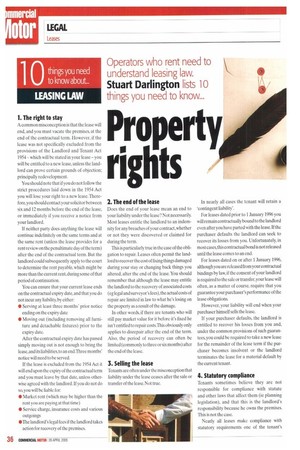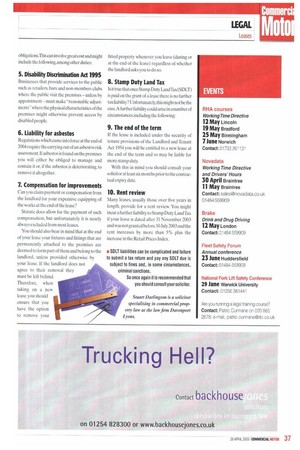Property rights
Page 38

Page 39

If you've noticed an error in this article please click here to report it so we can fix it.
Operators who rent need to understand leasing law.
Stuart Darlington lists 10
things you need to know...
10 things you need
to know about..
LEASING LAW
1. The right to stay
A common misconception is that the lease will end, and you must vacate the premises, at the end of the contractual term. However, if the lease was not specifically excluded from the provisions of the Landlord and Tenant Act 1954— which will be stated in your lease — you will be entitled to a new lease, unless the landlord can prove certain grounds of objection; principally redevelopment.
You should note that if you do not follow the strict procedures laid down in the 1954 Act you will lose your right to a new lease. Therefore, you should contact your solicitor between six and 12 months before the end of the lease, or immediately if you receive a notice from your landlord.
If neither party does anything the lease will continue indefmitely on the same terms and at the same rent (unless the lease provides for a rent review on the penultimate day of the term) after the end of the contractual term. But the landlord could subsequently apply to the court to determine the rent payable, which might be more than the current rent, during some of that period of continuation.
You can ensure that your current lease ends on the contractual expiry date, and that you do not incur any liability, by either: • Serving at least three months' prior notice ending on the expiry date • Moving out (including removing all furniture and detachable fixtures) prior to the expiry date.
After the contractual expiry date has passed simply moving out is not enough to bring the lease, and its liabilities,to an end.Three months' notice will need to be served.
If the lease is excluded from the 1954 Act it will end upon the expiry of the contractual term and you must leave by that date, unless otherwise agreed with the landlord. If you do not do so, you will be liable for: • Market rent (which may be higher than the rent you are paying at that time) • Service charge, insurance costs and various outgoings • The landlord's legal fees if the landlord takes action for recovery of the premises.
2. The end of the lease
Does the end of your lease mean an end to your liability under the lease? Not necessarily. Most leases entitle the landlord to an indemnity for any breaches of your contract, whether or not they were discovered or claimed for during the term.
This is particularly true in the case of the obligation to repair. Leases often permit the landlord to recover the cost of fixing things damaged during your stay or changing back things you altered, after the end of the lease. You should remember that although the lease may entitle the landlord to the recovery of associated costs (eg legal and surveyor's fees), the actual costs of repair are limited in law to what he's losing on the property as a result of the damage.
In other words, if there are tenants who will still pay market value for it before it's fixed he isn't entitled to repair costs.This obviously only applies to disrepair after the end of the term. Also, the period of recovery can often be limited (commonly to three or six months) after the end of the lease.
3. Selling the lease
Tenants are often under the misconception that liability under the lease ceases after the sale or transfer of the lease. Not true. In nearly all cases the tenant will retain a 'contingent liability'.
For leases dated prior to 1 January 1996 you will remain contractually bound to the landlord even after you have parted with the lease. If the purchaser defaults the landlord can seek to recover its losses from you. Unfortunately, in most cases, this contractual bond is not released until the lease comes to an end.
For leases dated on or after 1 January 1996, although you are released from your contractual bindings bylaw, if the consent of your landlord is required to the sale or transfer, your lease will often, as a matter of course, require that you guarantee your purchaser's performance of the lease obligations.
However, your liability will end when your purchaser himself sells the lease.
If your purchaser defaults, the landlord is entitled to recover his losses from you and, under the common provisions of such guarantees, you could be required to take a new lease for the remainder of the lease term if the purchaser becomes insolvent or the landlord terminates the lease for a material default by the current tenant.
4. Statutory compliance
Tenants sometimes believe they are not responsible for compliance with statute and other laws that affect them (ie planning legislation), and that this is the landlord's responsibility because he owns the premises. This is not the case.
Nearly all leases make compliance with statutory requirements one of the tenant's obligations:This can involve great cost and might include the following, among other duties: 5. Disability Discrimination Ad 1995 Businesses that provide services to the public such as retailers, bars and non-members clubs where the public visit the premises — unless by appointment — must make "reasonable adjustments-where the physical characteristics of the premises might otherwise prevent access by disabled people.
6. Liability for asbestos
Regulations which came into force at the end of 2004 require the carrying out of an asbestos risk assessment. If asbestos is found on the premises you will either be obliged to manage and contain it or. if the asbestos is deteriorating, to remove it altogether.
7. Compensation for improvements
Can you claim payment or compensation from the landlord for your expensive equipping of the works at the end of the lease?
Statute does allow for the payment of such compensation, hut unfortunately it is nearly always excluded from most leases.
You should also hear in mind that at the end of your lease your fixtures and fittings that are permanently attached to the premises are deemed to form part of them and belong to the landlord, unless provided otherwise by your lease. If the landlord does not agree to their removal they must be left behind. Therefore, when taking on a new lease you should ensure that you have the option to remove your fitted property whenever you leave (during or at the end of the lease) regardless of whether the landlord asks you to do so.
8. Stamp Duty Land Tax
Is it t rue that once Stamp Duty LandTax(SDLT) is paid on the grant of a lease there is no further tax liability? Unfortunately,this might not be the case.A further liability could arise in a number of circumstances, including the following:
9. The end of the term
If the lease is included under the security of tenure provisions of the Landlord and Tenant Act 1954 you will be entitled to a new lease at the end of the term and so may be liable for more stamp duty.
With this in mind you should consult your solicitor at least six months prior to the contractual expiry date.
10. Rent review
Many leases, usually those over five years in length, provide for a rent review. You might incur a further liability to Stamp Duty LandTax if your lease is dated after 31 November 2003 and was not granted before 10July 2003 and the rent increases by more than 5% plus the increase in the Retail Prices Index.










































































































































































































